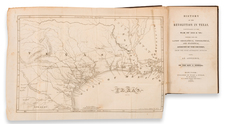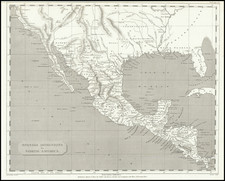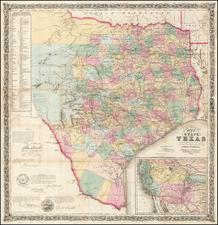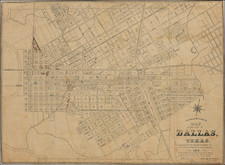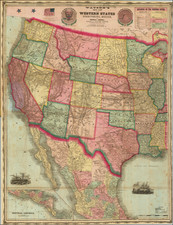An Early Reference to Bahia del Espíritu Santo
The Texas Gulf Coast in 1692
A rare 1692 letter, one of the earliest obtainable original documents concerning any part of what would become Texas. Dated at Mexico City in 1692, the present document contains a very early reference to a location on the Texas Gulf Coast - the Bahia del Espíritu Santo, present-day Matagorda Bay. Written by order of the Viceroy, the Count of Galve, by his secretary, Juan Francisco de Vargas Manuel de Lodeña, the text relates to money flows from the Royal Treasury outpost in Zacatecas, for expenditures related to the Bahia del Espíritu Santo on the Texas coast. Addressed to Royal Treasury officials in Zacatecas, the Viceroy's secretary requests certification of expenditures relating to Bahia del Espírtu Santo, from the year 1689 going forward. Such expenditures were almost certainly related to Spanish expeditions sent in response to the La Salle Expedition.
Texas in the 1690s: La Salle's Expedition and Bahía del Espíritu Santo
The context of the letter is significant in the early history of Texas. La Bahía del Espíritu Santo, or Bay of the Holy Spirit, located south of Houston on the Texas Gulf Coast is now called Matagorda Bay and Lavaca Bay. The use of the name Bahia del Espíritu Santo to refer to this part of Texas first occurred during the Spanish search for the French colony planted in the area by La Salle. The short-lived French colony at Fort St. Louis was destroyed by coastal Karankawa in 1689, and when the viceroy learned of its existence he sent out expeditions to reconnoiter and counter any French incursions in present-day Texas.
In 1689 the viceroy of New Spain reponded to reports of a French incursion in Texas by sending land and sea expeditions. Don Andrés Pez, a skilled seaman, was sent out from Vera Cruz in 1688-89 to examine the Gulf coast, but apparently he did not find evidence of the French fort at Bahia del Espíritu Santo (Matagorda Bay). An overland expedition under Alonso De León and Fray Damián Massanet did finally locate the ruins of the French fort of St. Louis. The viceroy, Gaspar de la Cerda Sandoval Silva y Mendoza, Conde de Galve, sent a new expedition, again headed by De León, the following year, made up of about a hundred soldiers and four missionary friars: Massanet, Miguel de Fontcuberta, Francisco Casañas de Jesús María, and Antonio de Bordoy. This time the Spanish located two survivors of La Salle's colony, from whom they gained more information about the ill-fated French expedition. These Spanish expeditions led to the first mission in the province of Texas, Mission San Francisco de los Tejas, established on May 24, 1690 at the erstwhile Indian village of Nabedache, near present-day Augusta, Texas. A chapel was built to celebrate the feast of Corpus Christi during which the Spanish flag was raised, and the native leader was given a cross, in honor of his commitment to facilitating the instruction of his people in the Catholic faith.
Given the date and content of our letter, which references expenditures concerning Bahia del Espíritu Santo back to the year 1689, it stands to reason that such expenditures relate to the Spanish response to the La Salle Expedition.
The year 1692 has long evoked a special meaning in Texas history. Going back to Edward Stiff's classic 1855 book, we see 1692 highlighted as an important moment as the beginning of European settlement in Texas: A New History of Texas; From the First European Settlement in 1692, Down to the Present Time.
The text of the document here follows:
Remito a V[uestras] m[erce]d[e]s de orden del conde mi Sr. el des[pach]o adjunto con f[ec]ha de 25 del pasado para que Vmds remitan certificacion de la ymportancia del desembolso suplemento y pagas de la R[ea]l caxa de su cargo desde principios del año de ochenta y nueve de las entradas a la Vahia del Espiritu Santo; con lo demas que expresa d[ic]ho despacho; de que me daran Vmds. aviso del mismo del en la primera ocasion para darsele a su [?]... que D[ios] G[uarda] a Vmds. muchos años. Mex[i]co 9 de nov[iemb]re de 1692.
de Vmds Servidor.... Juan Francisco de Bargas Manuel de Lodeña
Los oficiales r[eale]s de la ciud[ad] de Zacatecas
Translation
To the Royal Officials at the City of Zacatecas.
I send to your graces, by order of my Lord, the Count, the attached dispatch dated the 25th of last month, so that your graces may send certification of the importance of the supplementary expenditure and payments from the Royal Treasury under your charge, from the beginning of the year eighty-nine, for the entries to the Bay of the Holy Spirit; with the rest that said dispatch expresses; of which you will give me notice at the earliest opportunity to give it to your esteemed [?]... may God keep you many years. Mexico, 9th of November, 1692.
Your ... Servant ... Juan Francisco de Bargas Manuel de Lodeña
Rarity
Original documents from the 17th-century relating to what is now Texas are very rare in the market.
Provenance:
Hubert Hudson, former Texas Senator 1957-1963, Brownsville, Texas.











![[Manuscript Map and Grant Translation for Adolphe Sterne's Lands in Tyler County, Texas] Translation of Title to One League of Land to Adolfo Sterne [Tyler County, Texas land grant]](https://storage.googleapis.com/raremaps/img/small/85549.jpg)
